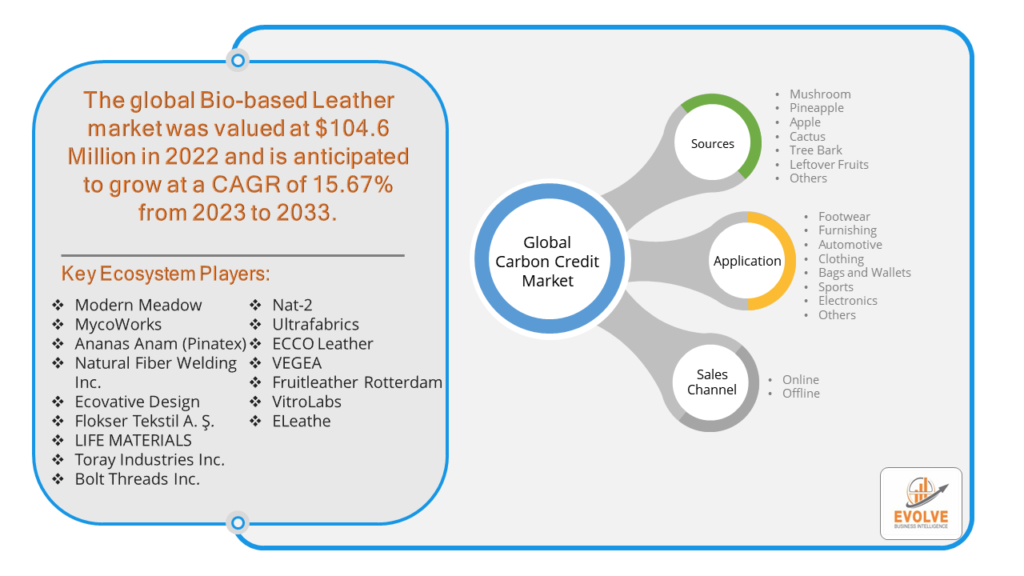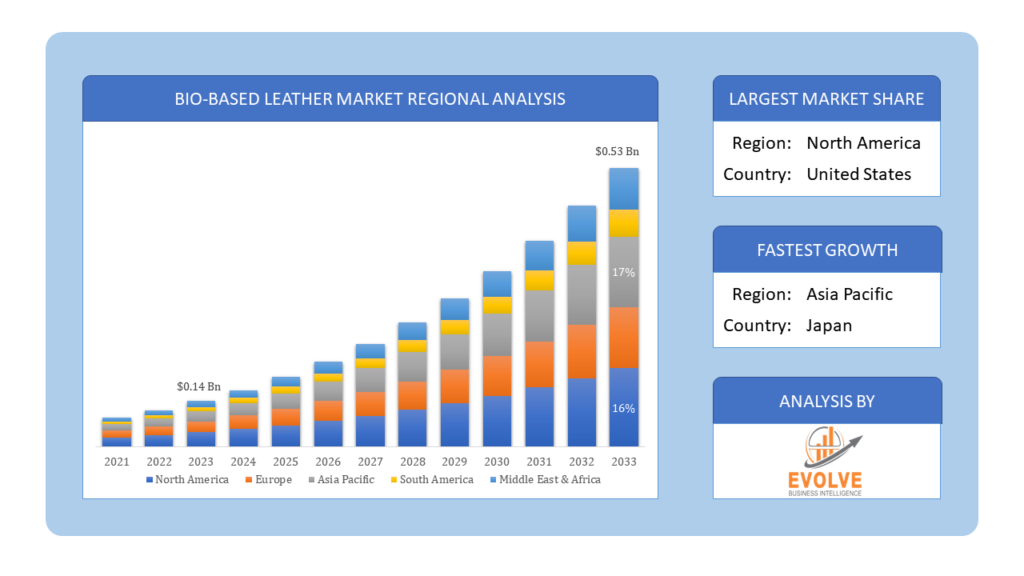Global Bio-based Leather Market Overview
The global Bio-based Leather market was valued at $104.6 Million in 2022 and is anticipated to grow at a CAGR of 15.67% from 2023 to 2033.
The Global Bio-based Leather Market refers to the market for leather-like materials that are derived from renewable biological sources rather than traditional animal hides. These bio-based leather alternatives are often developed using various organic materials such as plant fibers, fungi, and other biomaterials. The market encompasses products designed to mimic the properties of conventional leather, including texture, durability, and appearance, while offering environmental benefits such as reduced carbon footprint and decreased reliance on animal agriculture. The market for bio-based leather is driven by increasing consumer demand for sustainable and cruelty-free alternatives to traditional leather products, as well as growing awareness of the environmental impact of conventional leather production processes.
Global Bio-based Leather Market Synopsis
The COVID-19 pandemic had various impacts on the global bio-based leather market. Lockdown measures, restrictions on movement, and disruptions in transportation networks have led to challenges in the supply chain for bio-based leather manufacturers. This has resulted in delays in raw material procurement, production, and distribution. The pandemic has caused a decline in consumer spending, particularly on non-essential goods like fashion items, including leather products. Many consumers have become more price-conscious and have shifted their spending priorities towards essential items, impacting the demand for bio-based leather products. There has been a noticeable shift in consumer preferences towards more sustainable and environmentally friendly products, including bio-based leather. However, this trend may have been overshadowed by immediate concerns related to health and economic stability during the pandemic. The pandemic has accelerated the adoption of remote work and digitalization across industries. In the bio-based leather market, this trend may lead to increased reliance on online sales channels and digital marketing strategies as physical retail locations face restrictions and reduced foot traffic.
Global Bio-based Leather Market Dynamics
The major factors that have impacted the growth of Global Bio-based Leather Market are as follows:
Drivers:
Ø Innovations in Material Science
Advances in biotechnology and material science have enabled the development of bio-based materials with properties comparable to traditional leather. Researchers and manufacturers are continuously exploring new biomaterials, production methods, and finishing techniques to enhance the performance and aesthetics of bio-based leather, expanding its applications in various industries. Companies are increasingly incorporating sustainability into their branding strategies and corporate social responsibility initiatives to appeal to environmentally conscious consumers and differentiate themselves in the market. Adopting bio-based leather as a sustainable alternative aligns with these objectives, enhancing brand reputation and market competitiveness. The shift towards a circular economy, which emphasizes reducing waste and maximizing resource efficiency, has spurred interest in bio-based materials as part of sustainable product lifecycles. Bio-based leather can contribute to circularity by being biodegradable or recyclable, reducing the environmental impact associated with end-of-life disposal.
Restraint:
- Perception of Cost Considerations
Bio-based leather often requires innovative production processes and raw materials, which can be more expensive than traditional leather. The higher costs associated with research, development, and production may limit the affordability and accessibility of bio-based leather products, particularly in price-sensitive markets. The production and distribution infrastructure for bio-based leather materials may be underdeveloped compared to the established supply chains of traditional leather. Challenges such as sourcing consistent and sustainable raw materials, scaling up production capacity, and ensuring quality control may constrain the growth of the bio-based leather market.
Opportunity:
⮚ Growing Demand for Sustainable Products
Increasing awareness of environmental issues and changing consumer preferences towards sustainable and eco-friendly products present a significant opportunity for bio-based leather. As consumers seek alternatives to traditional leather that reduce carbon footprint and minimize environmental impact, bio-based leather stands to capture a growing market share. Bio-based leather offers versatility in applications beyond traditional leather goods such as footwear, apparel, and accessories. There is an opportunity to explore new markets and industries where bio-based leather can be utilized, including automotive interiors, furniture upholstery, interior design, and consumer electronics, among others. The rise of e-commerce platforms and digital marketing channels provides an opportunity for bio-based leather manufacturers to reach a wider audience of environmentally conscious consumers worldwide. Leveraging online platforms for sales, marketing, and brand promotion can enhance market visibility and accessibility, driving growth in the global bio-based leather market.
Global Bio-based Leather Market Segment Overview
By Sources
 Based on Sources, the market is segmented based on Mushroom, Pineapple, Apple, Cactus, Tree Bark, Leftover Fruits and Others. The pineapple segment accounted for a major share. Piatex is a bio-based type made from pineapple leaf fibers. Pineapple is increasingly being used to produce bio-based goods that make use of agricultural waste. The wasted pineapple leaves are gathered and washed, filtered, and dried to recover long fibers. The resulting product is then treated with corn-based polylactic acid to create a non-woven mesh. It is then coated to increase its strength, durability, and water resistance.
Based on Sources, the market is segmented based on Mushroom, Pineapple, Apple, Cactus, Tree Bark, Leftover Fruits and Others. The pineapple segment accounted for a major share. Piatex is a bio-based type made from pineapple leaf fibers. Pineapple is increasingly being used to produce bio-based goods that make use of agricultural waste. The wasted pineapple leaves are gathered and washed, filtered, and dried to recover long fibers. The resulting product is then treated with corn-based polylactic acid to create a non-woven mesh. It is then coated to increase its strength, durability, and water resistance.
By Application
Based on Application, the market segment has been divided into Footwear, Furnishing, Automotive, Clothing, Bags and Wallets, Sports, Electronics and Others. The footwear segment is dominant the market share. Bio-based leather is increasingly being used in the manufacturing of footwear as it is cruelty-free and environment-friendly. Bio-based leather is gaining momentum as an eco-friendly and cruelty free material choice, particularly in the automotive industry, where it’s used for car interiors and upholstery.
By Sales Channel
Based on Sales Channel, the market has been divided into Online and Offline. The Offline segment is dominant the market. The offline segment encompasses traditional brick-and-mortar retail channels, including physical stores, specialty boutiques, department stores, and shopping malls. Consumers have the opportunity to interact with products physically, examine the quality and texture of bio-based leather items, and receive personalized assistance from sales representatives. Bio-based leather brands may establish partnerships with offline retailers to showcase their products and reach a broader audience.
Global Bio-based Leather Market Regional Analysis
Based on region, the Global Bio-based Leather Market has been divided into North America, Europe, Asia-Pacific, the Middle East & Africa, and Latin America. North America is projected to dominate the use of the Global Bio-based Leather Market followed by the Asia-Pacific and Europe regions.
 Bio-based Leather North America Market
Bio-based Leather North America Market
North America holds a dominant position in the Global Bio-based Leather Market. North America is witnessing increasing consumer demand for sustainable and eco-friendly products, including bio-based leather. The region is characterized by a strong presence of innovative startups and established companies focusing on sustainable materials and technologies. Regulatory support for environmental initiatives and sustainability practices further drives market growth in the region.
Bio-based Leather Asia-Pacific Market
The Asia-Pacific region has indeed emerged as the fastest-growing market for the Global Bio-based Leather Market industry. Asia-Pacific is a rapidly growing market for bio-based leather, driven by increasing urbanization, rising disposable incomes, and changing consumer preferences. Countries like China, Japan, and South Korea are investing in sustainable technologies and materials, including bio-based leather, to address environmental challenges. Growing awareness of animal welfare and environmental sustainability among consumers in the region is fueling demand for cruelty-free and eco-friendly alternatives to traditional leather.
Competitive Landscape
The Global Bio-based Leather Market is highly competitive, with numerous players offering a wide range of software solutions. The competitive landscape is characterized by the presence of established companies, as well as emerging startups and niche players. To increase their market position and attract a wide consumer base, the businesses are employing various strategies, such as product launches, and strategic alliances.
Prominent Players:
- Modern Meadow
- MycoWorks
- Ananas Anam (Pinatex)
- Natural Fiber Welding Inc.
- Ecovative Design
- Flokser Tekstil A. Ş.
- LIFE MATERIALS
- Toray Industries Inc.
- Bolt Threads Inc.
- Nat-2
- Ultrafabrics
- ECCO Leather
- VEGEA
- Fruitleather Rotterdam
- VitroLabs
- ELeathe
Key Development
In October 2023, Luxury fashion brand stella McCartney has launched a new handbag collection made with bio-based leather. The collection features a variety of handbags, including totes, Crossbody bag and shoulder bags. The handbags are made with mirum, a bio-based leather material made from apple peels.
Scope of the Report
Global Bio-based Leather Market, by Sources
- Mushroom
- Pineapple
- Apple
- Cactus
- Tree Bark
- Leftover Fruits
- Others
Global Bio-based Leather Market, by Application
- Footwear
- Furnishing
- Automotive
- Clothing
- Bags and Wallets
- Sports
- Electronics
- Others
Global Bio-based Leather Market, by Sales Channel
- Online
- Offline
Global Bio-based Leather Market, by Region
- North America
- US
- Canada
- Mexico
- Europe
- UK
- Germany
- France
- Italy
- Spain
- Benelux
- Nordic
- Rest of Europe
- Asia Pacific
- China
- Japan
- South Korea
- Indonesia
- Austalia
- Malaysia
- India
- Rest of Asia Pacific
- South America
- Brazil
- Argentina
- Rest of SouthAmerica
- Middle East &Africa
- Saudi Arabia
- UAE
- Egypt
- SouthAfrica
- Rest of Middle East & Africa
| Parameters | Indicators |
|---|---|
| Market Size | 2033: $104.6 Million |
| CAGR | 15.67% CAGR (2023-2033) |
| Base year | 2022 |
| Forecast Period | 2023-2033 |
| Historical Data | 2021 |
| Report Coverage | Revenue Forecast, Competitive Landscape, Growth Factors, and Trends |
| Key Segmentations | Sources, Application, Sales Channel |
| Geographies Covered | North America, Europe, Asia-Pacific, Latin America, Middle East, Africa |
| Key Vendors | Modern Meadow, MycoWorks, Ananas Anam (Pinatex), Natural Fiber Welding Inc., Ecovative Design, Flokser Tekstil A. S., LIFE MATERIALS, Toray Industries Inc., Bolt Threads Inc., Nat-2, Ultrafabrics, ECCO Leather, VEGEA, Fruitleather Rotterdam, VitroLabs and ELeathe |
| Key Market Opportunities | • Growing Demand for Sustainable Products • E-commerce and Digital Marketing |
| Key Market Drivers | • Innovations in Material Science • Circular Economy Initiatives |
REPORT CONTENT BRIEF:
- High-level analysis of the current and future Global Bio-based Leather Market trends and opportunities
- Detailed analysis of current market drivers, restraining factors, and opportunities in the future
- Global Bio-based Leather Market historical market size for the year 2021, and forecast from 2023 to 2033
- Global Bio-based Leather Market share analysis at each product level
- Competitor analysis with detailed insight into its product segment, Government & Defense strength, and strategies adopted.
- Identifies key strategies adopted including product launches and developments, mergers and acquisitions, joint ventures, collaborations, and partnerships as well as funding taken and investment done, among others.
- To identify and understand the various factors involved in the Global Bio-based Leather Market affected by the pandemic
- To provide a detailed insight into the major companies operating in the market. The profiling will include the Government & Defense health of the company’s past 2-3 years with segmental and regional revenue breakup, product offering, recent developments, SWOT analysis, and key strategies.









